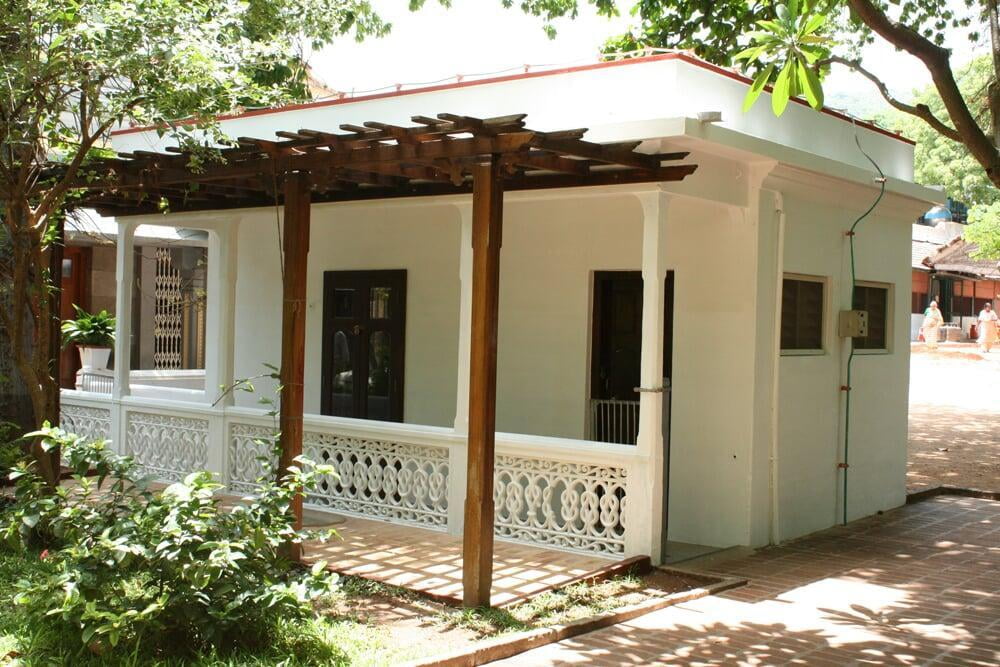Visiting Us
Tiruvannamalai
Tiruvannamalai is well-connected and easily accessible from anywhere in the country. Depending on your starting point, you can choose between air, rail, or road travel for a convenient journey.
By Air: The normal airport is Chennai International Airport, located 172 km away. This airport offers frequent flights to major cities across India. The other nearby airports are located at 100 km west at Puducherry (Pondicherry), and about 200 km southeast at Bengaluru. From the airport, taxis are readily available to take you directly to Tiruvannamalai.
By Rail: Tiruvannamalai has its own railway station, which links the town to major cities like Chennai, Madurai, Tirupati, Pondicherry, and Vellore. These cities are further connected to the rest of the country through an extensive railway network.
By Road: Tiruvannamalai is easily reachable by road from cities such as Bengaluru, Chennai, Vellore, and Madurai. The town is well-connected by national highways NH 234, NH 66, and NH 289. You can travel by Tamil Nadu state buses or hire a taxi for a more personalized journey.
Taxis are also available for visitors traveling to the ashram from different points in South India. The Ashram is about 3 km from the Tiruvannamalai railway station. It is about the same distance from the bus stations and 2 km south of the Main Temple.
Climate
It is generally hot and dry for most of the year. Light cotton clothing is advised.
April-May are the hottest months. Temperatures in the mid-forties (centigrade) are not uncommon.
By mid-June, while the rest of India enjoys the southwest monsoon, Tamil Nadu falls in the rain shadow of the Western Ghats, and only a few spillover showers occur, though bringing a welcome drop in temperature.
The true rainy season (the northeast monsoon) for this part of South India is October–November, when the weather is wet and moderate.
Winter (Dec-Jan) is quite brief. It is pleasant during the day, and a light woolen garment for the night and early mornings is adequate.
Proper Clothing
Proper Clothing
Visitors kindly respect the local culture by wearing clothing that completely covers the knees and shoulders.
Entering the Ashram
Entering the Ashram

After passing beneath the arch that announces the name of the ashram, the visitor will cross a large open courtyard flanked by shady trees, one of which is a 400-year-old Iluppai tree. Above him to the left arise two towers in the traditional Dravidian style of temple architecture. One surmounts the Matrubhuteswara Shrine, erected over the tomb of Sri Maharshi’s mother, and the other is over the New Hall.
The New Hall
The New Hall
On entering the New Hall, the objects that first attract the visitor’s attention are a life-sized statue of Sri Maharshi and a large yogasana, or couch, beautifully carved from a single stone and polished to look like black marble. This hall was specially built to accommodate the increasing number of devotees for whom the Old Hall, described below, was found to be too small. But Sri Maharshi used the New Hall and the couch for only the few months leading up to his Mahanirvana.
Matrubhuteswara Temple
Matrubhuteswara Temple
The door in the western wall of the New Hall leads directly ahead into the Matrubhuteswara Shrine. This imposing shrine was constructed under the personal supervision of Vaidyanatha Stapati, a famous temple sculptor and architect. The Garbha Griha (sanctum sanctorum) contains a sacred Siva Linga and a Sri Chakra Meru, sanctified by Sri Maharshi’s own touch. A special worship known as the Sri Chakra Puja is conducted here on all Fridays, full moon days, and the first day of all twelve solar months. On the outer walls of the Garbha Griha are the sculpted images of Dakshinamurti, Lingodbhava Murti, Vishnu, and Lakshmi. At the southwest and northwest corners, one finds two diminutive shrines dedicated to the gods Ganesa and Subrahmanya, respectively.
There is a similar shrine to Chandikeswara on the northern side. The Nava Grahas (nine planets) find their place in the northeast corner. The pillars supporting the roof contain several images of gods and goddesses. A small Nandi, or bull, is placed on a high pedestal facing the entrance to the Garbha Griha. The entire shrine is built of superior granite.
Sri Maharshi’s Samadhi
Sri Maharshi’s Samadhi
Passing out of Mother’s shrine through a door in the northern wall, one comes to the shrine built over Sri Maharshi’s tomb. This consists of a mantap (a large raised platform) with a vimana, or tower, surmounting it. Four large, carved pillars of granite, polished to look like black marble, support this tower. The beams are similarly carved and polished. A lotus of white marble adorns the center of the mantap, and over it is installed a sacred Siva Linga. A large, marble-floored meditation hall encloses this shrine.
The Old Hall
The Old Hall
Passing through the door of the Samadhi Hall on the north side the visitor comes to the Old Hall. This and the Nirvana Room, to be described shortly, are regarded as spots particularly sanctified by the Maharshi’s presence. In this hall thousands of devotees had his darshan (seeing a holy person or an image). It was on the couch in this hall that he spent almost all his time until about a year before his passing. It was here that devotees experienced year after year the potent peace that emanated from his presence. To this day the Old Hall remains a favorite place for meditation of visitors and inmates alike.
The Dining Hall
The Dining Hall
The dining hall and its new extension can accommodate nearly 800 people, and the kitchen is large enough to cook, on special occasions like Jayanti (Sri Maharshi’s birthday), meals for as many as two or three thousand people. The place where Sri Maharshi used to sit for his meals in the dining hall is indicated by a large photograph of him that rests on a marble platform. Passing through the old dining hall and out the door on the north side, we enter the new dining hall, which was built in recent years to accommodate the ever-increasing number of pilgrims. To the east of the kitchen, separated from it by a passage, is a storeroom for provisions. Another passage separates the storeroom from the room for men situated to the south of it. This passage leads to the Veda Patasala or the boarding school where young boys are taught to chant the Vedas and further on to the gosala in which the Ashram cows are kept. Further east are the bathrooms.
Gosala : The Ashram dairy and cattle farm which provides wholesome dairy products for in-house needs.
Vedapatasala : Yajurveda school where students of the Vedas are trained in their traditional vocation.
The Nirvana Room
The Nirvana Room

The small Nirvana Room, situated to the east of the New Hall and north of the office, is the room in which Sri Maharshi spent his last days and is thus a spot viewed with special reverence. It is kept as it was in his time. To the south of this sacred spot and facing the Mother’s Temple is the shrine erected over the samadhi of Sri Niranjanananda Swami, the Maharshi’s younger brother and the Sarvadhikari or manager of the Ashram as long as he lived. A fine grove of coconut trees flanks this mantap and the Nirvana Room and stretches to the east.
Guest Rooms
Guest Rooms
Since Sri Maharshi’s Mahanirvana, many new guest rooms have been constructed in and around the ashram. Additional guest rooms and cottages have been built to the west of the Pali Tirtham (tank), which during the early days constituted part of Palakuttu, a forested area where the Maharshi often walked. All the guest rooms are clean, with simple beds, a bathroom, an overhead fan, and screened windows and doors. To preserve the quiet and intimate experience of a visit to Sri Ramanasramam, the administration decided to halt the new construction of guest rooms within the Ashram borders. Instead, the ashram has built guest facilities outside of its premises within walking distance.
Dispensary: Free medical aid for the ashram inmates and local people.
Book Store : Available are Sri Ramana literature, including original works, biographies, commentaries, and reminiscences, in various languages. Also photographs, souvenirs, audio tapes, videos, CDs, and other media.
The Mountain Path : the quarterly journal published by Sri Ramanasramam and circulated worldwide.
Sri Ramana Library
Sri Ramana Library

This library, located in the Ashram compound, has an extensive collection of books on spiritual matters in various languages. It is open from 8.30 a.m. to 11 a.m. in the morning and 2 p.m. to 5 p.m. in the afternoon. Visitors are welcome to browse; membership is required to borrow books.
Skandasramam : This lovely tree-shaded hermitage on the Hill overlooking the Big Temple is where Bhagavan lived from 1916 to 1922;
Virupaksha Cave : has the shape of the sacred “Om” and contains the samadhi of Sage Virupaksha. Bhagavan Sri Ramana lived here from 1899 to 1916. Both caves are historical sites preserved and maintained by Sri Ramanasramam for the benefit of visitors.
Ashram in Google Map
Ashram in Google Map

